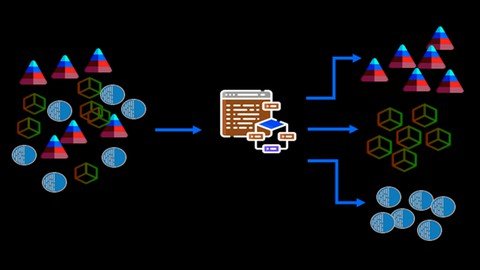
Published 7/2022
MP4 | Video: h264, 1280x720 | Audio: AAC, 44.1 KHz
Language: English | Size: 197.17 MB | Duration: 0h 47m
A Quick Way to Learn and Implement Clustering Algorithms for Pattern Recognition in Python. A Course for Beginners.
What you'll learn
Describe the input and output of a clustering model
Prepare data with feature engineering techniques
Implement K-Means Clustering, Hierarchical Clustering, Mean Shift Clustering, DBSCAN, OPTICS and Spectral Clustering models
Determine the optimal number of clusters
Use a variety of performance metrics such as Silhouette Score, Calinski-Harabasz Index and Davies-Bouldin Index.
Requirements
Basic knowledge of Python Programming
Description
Artificial intelligence and machine learning are touching our everyday lives in more-and-more ways. There's an endless supply of industries and applications that machine learning can make more efficient and intelligent. You have probably come across Google News, which automatically groups similar news articles under a topic. Have you ever wondered what process runs in the background to arrive at these groups? Unsupervised machine learning is the underlying method behind a large part of this. Unsupervised machine learning algorithms analyze and cluster unlabeled datasets. These algorithms discover hidden patterns or data groupings without human intervention. This course introduces you to one of the prominent modelling families of Unsupervised Machine Learning called Clustering. This course provides the learners with the foundational knowledge to use Clustering models to create insights. You will become familiar with the most successful and widely used Clustering techniques, such as:K-Means ClusteringHierarchical ClusteringMean Shift ClusteringDBSCAN : Density-Based Spatial Clustering of Applications with NoiseOPTICS : Ordering points to identify the clustering structureSpectral ClusteringYou will learn how to train clustering models to cluster and use performance metrics to compare different models. By the end of this course, you will be able to build machine learning models to make clusters using your data. The complete Python programs and datasets included in the class are also available for download. This course is designed most straightforwardly to utilize your time wisely. Get ready to do more learning than your machine!Happy Learning.Career Growth:Employment website Indeed has listed machine learning engineers as #1 among The Best Jobs in the U.S., citing a 344% growth rate and a median salary of $146,085 per year. Overall, computer and information technology jobs are booming, with employment projected to grow 11% from 2019 to 2029.
Overview
Section 1: Introduction
Lecture 1 Introduction
Lecture 2 Artificial Intelligence
Lecture 3 Machine Learning
Lecture 4 Supervised Learning
Lecture 5 Supervised Learning: Classifications
Lecture 6 Supervised Learning: Regressions
Lecture 7 Unsupervised Learning
Lecture 8 Unsupervised Learning : Clustering
Lecture 9 Installation of Python Platform
Section 2: Building and Evaluating Clustering ML Models
Lecture 10 Important Terminologies
Lecture 11 K-Means Clustering
Lecture 12 Hierarchical Clustering
Lecture 13 Silhouette Score
Lecture 14 Calinski-Harabasz Index (Variance Ratio Criterion)
Lecture 15 Davies-Bouldin Index
Lecture 16 Mean Shift Clustering
Lecture 17 DBSCAN : Density Based Spatial Clustering of Applications with Noise
Lecture 18 OPTICS : Ordering points to identify the clustering structure
Lecture 19 Spectral Clustering
Beginners starting out to the field of Machine Learning.,Industry professionals and aspiring data scientists.,People who want to know how to write their clustering code.
Homepage
https://www.udemy.com/course/clusteranalysis/
https://rapidgator.net/file/a6cfa2c70819a4e75630de6f701b4600/etvjs.Cluster.Analysis..Unsupervised.Machine.Learning.In.Python..udemy.rar.html

https://uploadgig.com/file/download/768662ef19454b8d/etvjs.Cluster.Analysis..Unsupervised.Machine.Learning.In.Python..udemy.rar
nitroflare.com:
https://nitroflare.com/view/3C50409E6E02712/etvjs.Cluster.Analysis..Unsupervised.Machine.Learning.In.Python..udemy.rar
